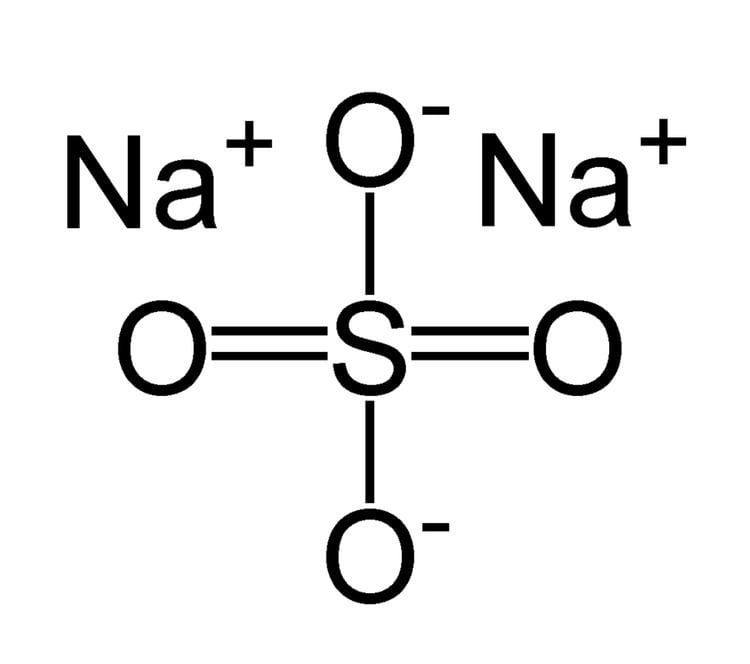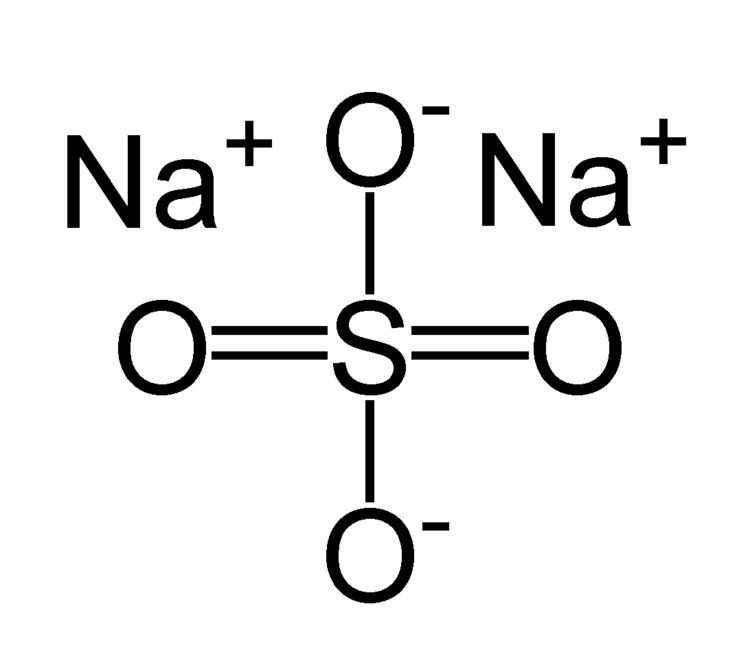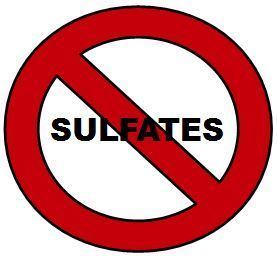Formula SO42- Soluble in Water ChemSpider ID 1085 | Molar mass 96.06 g/mol ChEBI ID 16189 | |
 | ||
The sulfate or sulphate (see spelling differences) ion is a polyatomic anion with the empirical formula SO2−
4. Sulfate is the spelling recommended by IUPAC, but sulphate is used in British English. Salts, acid derivatives, and peroxides of sulfate are widely used in industry. Sulfates occur widely in everyday life. Sulfates are salts of sulfuric acid and many are prepared from that acid.
Contents
- Shampoo is bad sulfate free shampoo
- Structure
- Bonding
- Preparation
- Properties
- Commercial applications
- Occurrence in nature
- History
- Environmental effects
- Main effects on climate
- Hydrogen sulfate bisulfate
- References

Shampoo is bad sulfate free shampoo
Structure
The sulfate anion consists of a central sulfur atom surrounded by four equivalent oxygen atoms in a tetrahedral arrangement. The symmetry is the same as that of methane. The sulfur atom is in the +6 oxidation state while the four oxygen atoms are each in the state. The sulfate ion carries an overall charge of −2 and it is the conjugate base of the bisulfate (or hydrogen sulfate) ion, HSO−
4, which is in turn the conjugate base of H
2SO
4, sulfuric acid. Organic sulfate esters, such as dimethyl sulfate, are covalent compounds and esters of sulfuric acid. The tetrahedral molecular geometry of the sulfate ion is as predicted by VSEPR theory.
Bonding

The first description of the bonding in modern terms was by Gilbert Lewis in his groundbreaking paper of 1916 where he described the bonding in terms of electron octets around each atom, that is no double bonds and a formal charge of +2 on the sulfur atom.

Later, Linus Pauling used valence bond theory to propose that the most significant resonance canonicals had two pi bonds involving d orbitals. His reasoning was that the charge on sulfur was thus reduced, in accordance with his principle of electroneutrality. The S−O bond length of 149 pm is shorter than the bond lengths in sulfuric acid of 157 pm for S−OH. The double bonding was taken by Pauling to account for the shortness of the S−O bond. Pauling's use of d orbitals provoked a debate on the relative importance of π bonding and bond polarity (electrostatic attraction) in causing the shortening of the S−O bond. The outcome was a broad consensus that d orbitals play a role, but are not as significant as Pauling had believed.

A widely accepted description involving pπ – dπ bonding was initially proposed by D. W. J. Cruickshank. In this model, fully occupied p orbitals on oxygen overlap with empty sulfur d orbitals (principally the dz2 and dx2–y2). However, in this description, despite there being some π character to the S−O bonds, the bond has significant ionic character. For sulfuric acid, computational analysis (with natural bond orbitals) confirms a clear positive charge on sulfur (theoretically +2.45) and a low 3d occupancy. Therefore, the representation with four single bonds is the optimal Lewis structure rather than the one with two double bonds (thus the Lewis model, not the Pauling model). In this model, the structure obeys the octet rule and the charge distribution is in agreement with the electronegativity of the atoms. The discrepancy between the S−O bond length in the sulfate ion and the S−OH bond length in sulfuric acid is explained by donation of p-orbital electrons from the terminal S=O bonds in sulfuric acid into the antibonding S−OH orbitals, weakening them resulting in the longer bond length of the latter.

However, the bonding representation of Pauling for sulfate and other main group compounds with oxygen is still a common way of representing the bonding in many textbooks. The apparent contradiction can be cleared if one realizes that the covalent double bonds in the Lewis structure in reality represent bonds that are strongly polarized by more than 90% towards the oxygen atom. On the other hand, in the structure with an ionic bond, the charge is localized as a lone pair on the oxygen.
Preparation
Methods of preparing metal sulfates include:
Properties

Many examples of ionic sulfates are known, and many of these are highly soluble in water. Exceptions include calcium sulfate, strontium sulfate, lead(II) sulfate, and barium sulfate, which are poorly soluble. Radium sulfate is the most insoluble sulfate known. The barium derivative is useful in the gravimetric analysis of sulfate: if one adds a solution of, perhaps, barium chloride to a solution containing sulfate ions, the appearance of a white precipitate, which is barium sulfate, indicates that sulfate anions are present.
The sulfate ion can act as a ligand attaching either by one oxygen (monodentate) or by two oxygens as either a chelate or a bridge. An example is the neutral metal complex PtSO4(P(C6H5)3)2 where the sulfate ion is acting as a bidentate ligand. The metal–oxygen bonds in sulfate complexes can have significant covalent character.
Commercial applications
Sulfates are widely used industrially. Major compounds include:
Occurrence in nature
Sulfate-reducing bacteria, some anaerobic microorganisms, such as those living in sediment or near deep sea thermal vents, use the reduction of sulfates coupled with the oxidation of organic compounds or hydrogen as an energy source for chemosynthesis.
History
Some sulfates were known to alchemists. The vitriol salts, from the Latin vitreolum, glassy, were so-called because they were some of the first transparent crystals known. Green vitriol is iron(II) sulfate heptahydrate, FeSO4·7H2O; blue vitriol is copper(II) sulfate pentahydrate, CuSO4·5H2O and white vitriol is zinc sulfate heptahydrate, ZnSO4·7H2O. Alum, a double sulfate of potassium and aluminium with the formula K2Al2(SO4)4·24H2O, figured in the development of the chemical industry.
Environmental effects
Sulfates occur as microscopic particles (aerosols) resulting from fossil fuel and biomass combustion. They increase the acidity of the atmosphere and form acid rain. The anaerobic sulfate-reducing bacteria Desulfovibrio desulfuricans and D. vulgaris can remove the black sulfate crust that often tarnishes buildings.
Main effects on climate
The main direct effect of sulfates on the climate involves the scattering of light, effectively increasing the Earth's albedo. This effect is moderately well understood and leads to a cooling from the negative radiative forcing of about 0.4 W/m2 relative to pre-industrial values, partially offsetting the larger (about 2.4 W/m2) warming effect of greenhouse gases. The effect is strongly spatially non-uniform, being largest downstream of large industrial areas.
The first indirect effect is also known as the Twomey effect. Sulfate aerosols can act as cloud condensation nuclei and this leads to greater numbers of smaller droplets of water. Lots of smaller droplets can diffuse light more efficiently than just a few larger droplets.
The second indirect effect is the further knock-on effects of having more cloud condensation nuclei. It is proposed that these include the suppression of drizzle, increased cloud height, to facilitate cloud formation at low humidities and longer cloud lifetime. Sulfate may also result in changes in the particle size distribution, which can affect the clouds radiative properties in ways that are not fully understood. Chemical effects such as the dissolution of soluble gases and slightly soluble substances, surface tension depression by organic substances and accommodation coefficient changes are also included in the second indirect effect.
The indirect effects probably have a cooling effect, perhaps up to 2 W/m2, although the uncertainty is very large. Sulfates are therefore implicated in global dimming.
Hydrogen sulfate (bisulfate)
The conjugate base of sulfuric acid (H2SO4)—a dense, colourless, oily, corrosive liquid—is the hydrogen sulfate ion (HSO−
4), also called the bisulfate ion. Sulfuric acid is classified as a strong acid; in aqueous solutions it ionizes completely to form hydronium ions (H3O+) and hydrogen sulfate (HSO−
4). In other words, the sulfuric acid behaves as a Brønsted–Lowry acid and is deprotonated. Bisulfate has a molar mass of 97.078 g/mol. It has a valency of 1. An example of a salt containing the HSO−
4 group is sodium bisulfate, NaHSO4. In dilute solutions the hydrogen sulfate ions also dissociate, forming more hydronium ions and sulfate ions (SO2−
4). The CAS registry number for hydrogen sulfate is 14996-02-2.
